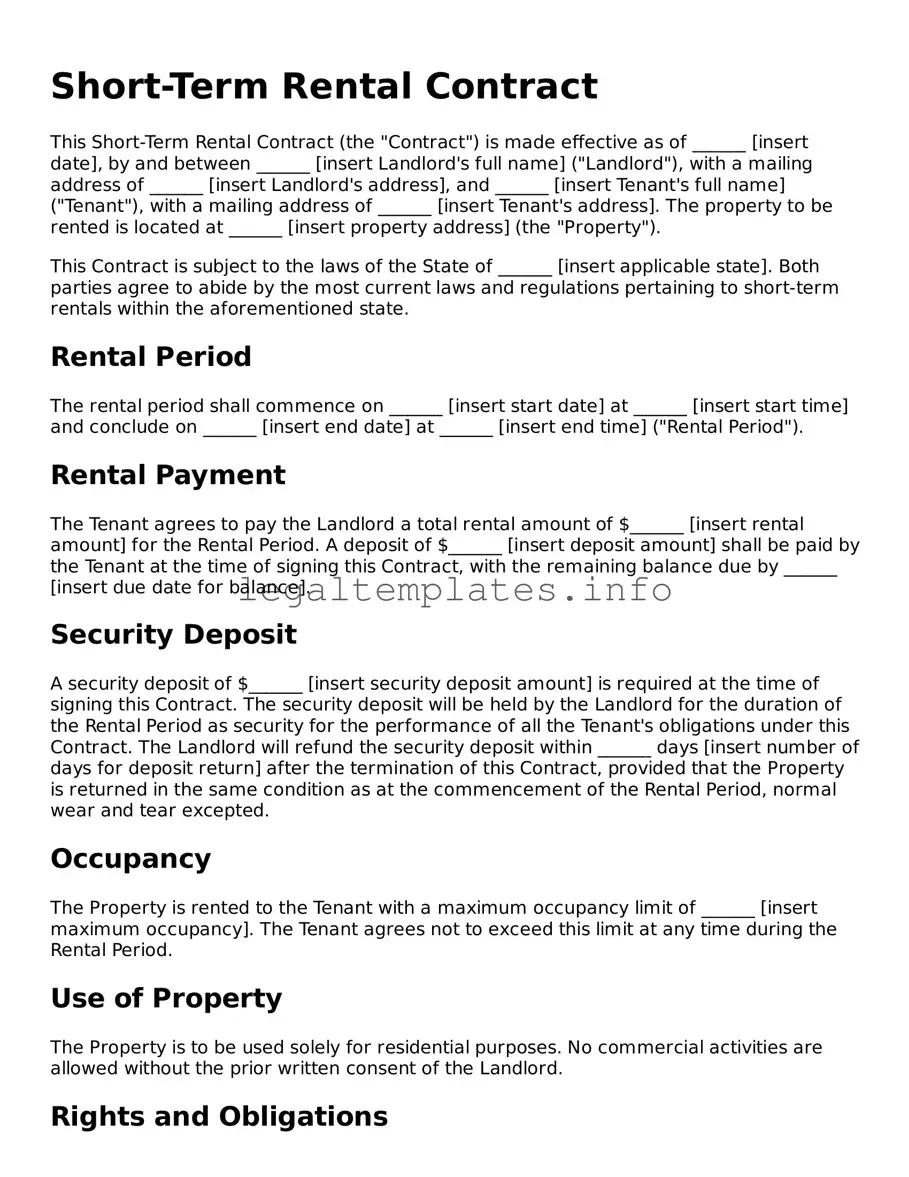Short-Term Rental Contract
This Short-Term Rental Contract (the "Contract") is made effective as of ______ [insert date], by and between ______ [insert Landlord's full name] ("Landlord"), with a mailing address of ______ [insert Landlord's address], and ______ [insert Tenant's full name] ("Tenant"), with a mailing address of ______ [insert Tenant's address]. The property to be rented is located at ______ [insert property address] (the "Property").
This Contract is subject to the laws of the State of ______ [insert applicable state]. Both parties agree to abide by the most current laws and regulations pertaining to short-term rentals within the aforementioned state.
Rental Period
The rental period shall commence on ______ [insert start date] at ______ [insert start time] and conclude on ______ [insert end date] at ______ [insert end time] ("Rental Period").
Rental Payment
The Tenant agrees to pay the Landlord a total rental amount of $______ [insert rental amount] for the Rental Period. A deposit of $______ [insert deposit amount] shall be paid by the Tenant at the time of signing this Contract, with the remaining balance due by ______ [insert due date for balance].
Security Deposit
A security deposit of $______ [insert security deposit amount] is required at the time of signing this Contract. The security deposit will be held by the Landlord for the duration of the Rental Period as security for the performance of all the Tenant's obligations under this Contract. The Landlord will refund the security deposit within ______ days [insert number of days for deposit return] after the termination of this Contract, provided that the Property is returned in the same condition as at the commencement of the Rental Period, normal wear and tear excepted.
Occupancy
The Property is rented to the Tenant with a maximum occupancy limit of ______ [insert maximum occupancy]. The Tenant agrees not to exceed this limit at any time during the Rental Period.
Use of Property
The Property is to be used solely for residential purposes. No commercial activities are allowed without the prior written consent of the Landlord.
Rights and Obligations
- The Tenant shall maintain the Property in a clean and sanitary condition and shall immediately inform the Landlord of any damage or repairs needed.
- The Landlord shall be responsible for all repairs to the Property required due to ordinary wear and tear.
- The Tenant agrees not to engage in any illegal activities on the Property.
- The Tenant shall not sublet the Property or assign this Contract without the written consent of the Landlord.
Cancellation Policy
Any cancellation must be made in writing. If the Tenant cancels the booking more than ______ [insert number of days] days before the start of the Rental Period, the Tenant will receive a full refund of the deposit. If the cancellation occurs less than ______ [insert number of days] days before the start of the Rental Period, the deposit is non-refundable.
Liability
The Tenant shall be responsible for any damage to the Property or its contents during the Rental Period, excluding normal wear and tear. The Tenant agrees to indemnify and hold harmless the Landlord from any liability for personal injury or property damage sustained by any person (including the Tenant) as a result of any carelessness, negligence, or improper conduct of any persons entering, occupying, or using the Property during the period of this Contract.
Additional Terms
Any additional terms agreed upon by both parties should be written below:
______________________________________________________________________________
______________________________________________________________________________
Signatures
This Contract is agreed upon and accepted by the below signed:
Landlord: ___________________________________ Date: ______
Tenant: _____________________________________ Date: ______
